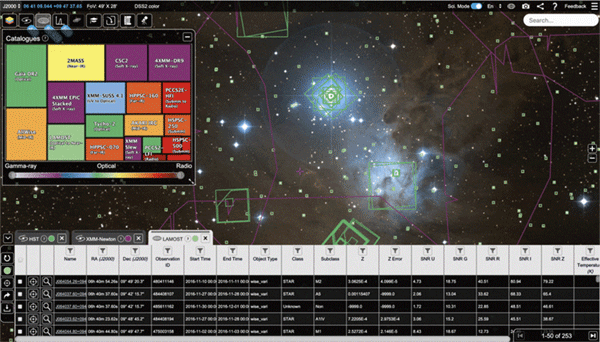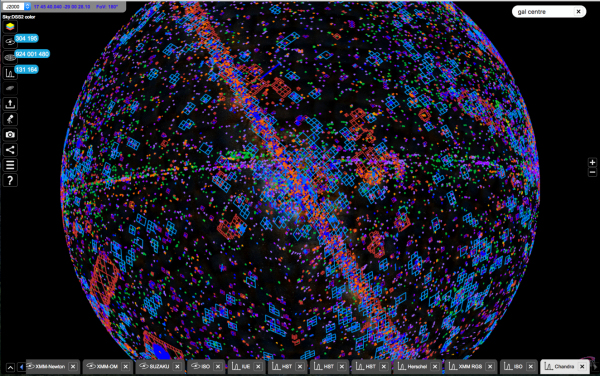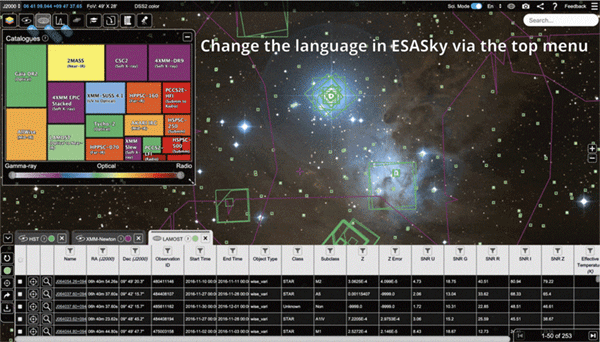ESASky launches in Chinese language
11 June 2020
ESA's world-leading interactive celestial atlas, ESASky, has now been translated into Mandarin. Alongside its English and Spanish language versions, this makes ESASky available to an ever growing community of professional and amateur astronomers worldwide. |
| ESASky available in Mandarin. Credit: ESA |
ESASky is a discovery portal that provides full access to the entire sky. It is a web-based application allowing users to zoom in on any celestial object they may be interested in. Once there, they can look at data collected from more than fifty among space missions and ground-based observatories across all frequencies of the electromagnetic spectrum.
Containing data collected since 1978, ESASky now contains more than half a million images, almost nine and a half million spectra and catalogues that list around three billion sources. With a source inventory that ranges from planets, moons, asteroids and comets in our Solar System to stars, the interstellar medium that pervades our Milky Way galaxy and external galaxies far beyond our own, ESASky is rapidly becoming the go-to interface to visualise and access astronomical data taken by any mission in space or by any large ground-based observatory.
The application is under the responsibility of the ESAC Science Data Centre (ESDC), based at the European Space Astronomy Centre (ESAC), Madrid, Spain.
"We'd been getting feedback from users of our astronomy archives that they'd like one easy interface to access all data," says Deborah Baines, ESA's Astronomy Archives Science Lead.
"More and more astronomers are working in multiple wavelengths now. So they need data from all regions of the electromagnetic spectrum, but they often don't have the time to go to the specific archives and reduce the data and so on. They want to be able to find science-ready data," says Baines.
 |
| An all-inclusive astronomical atlas. Credit: ESA |
Traditionally, astronomers have concentrated their research in individual wavebands, for example, specialising in radio astronomy or X-ray astronomy. They would learn how the data was collected with the specific instrumentations of that particular field, and how to process the raw observations into useable 'science-ready' data, a process called data reduction. However, the archives team noticed that as more and more mission data became available, this traditional workflow was disappearing.
"An astronomer doesn't always care if the data has been taken by an ESA space mission or a ground-based observatory, they just want to be able to get the data easily, and fast," says Baines. The easier it is for an astronomer to find the data needed, the easier it is for progress to be made.
So, in 2014, the ESA Archives team put together a prototype of ESASky. With the feedback they received from users, they developed and adapted the app to the point of first release in 2016.
As well as being a hit with professional astronomers, it has also become a resource for amateur astronomers and members of the general public who like to 'browse' the wonders of the Universe. They constituted more than a third of all ESASky visitors last year and their numbers continue to grow. To help them, the team invested effort to make the app's design responsive so it can be used on mobile devices.
Since ESDC is based in Spain, translation into Spanish was an obvious next step, with native Spanish speakers on the team who could handle translations on the fly. The Mandarin translation, aimed at reaching larger segments of the professional and amateur astronomical community, was made possible thanks to a collaboration with colleagues from China's Large Sky Area Multi Object Spectroscopic Telescope (LAMOST), with the ESASky team offering to incorporate the observatory's data into the platform and their Chinese counterparts offering to translate the app.
 |
| ESASky available in Mandarin. Credit: ESA |
Chenzhou Cui of the National Astronomical Observatories, Chinese Academy of Sciences (NAOC, CAS) is the executive director of China's National Astronomical Data Center and the principal investigator of the China Virtual Observatory, an online astronomical research and education 'environment' that provides seamless, global access to astronomical information. He is ESDC's chief point of contact for the translation and integration work.
"The ESASky project brings together data and astronomers from all over the world. It is a valuable asset on many levels, from astronomy to space science, from professional users to education and public outreach, from basic research to Big Data and cloud computing leading information and communications technology," says Cui.
In the future, the ESASky team will be adding more datasets from ESA, NASA, the Japan Aerospace Exploration Agency (JAXA), the CAS, and other major astronomical data centres. Thanks to the data protocols set by the International Virtual Observatory Alliance and the opportunities for collaboration in this context, the app can now access information taken by ground based observatories such as the European Southern Observatory, and can integrate data from NASA's Mikulski Archive for Space Telescopes (MAST) and the Canadian Astronomy Data Centre (CADC). The team is also planning to extend ESASky to other languages in the future as well.
"The big aim is to make ESASky a gateway for astronomers to find all data that's been taken," says Bruno Merín, Head of the ESAC Science Data Centre.
Notes for Editors
ESASky was launched by ESA in 2016. It is developed by the ESAC Science Data Centre (ESDC) at the European Space Astronomy Centre (ESAC) near Madrid, Spain. It works as a top-level search interface to the Astronomy Science Archives, which are developed and maintained by the ESDC, in coordination with the science operations centres and consortia of the various missions.
ESASky makes use of Aladin Lite, a lightweight sky atlas running in the browser, developed by the Centre de Données astronomiques de Strasbourg (CDS), Strasbourg Observatory, France.
For further information, please contact:
Bruno Merín
Head of the ESAC Science Data Centre
European Space Astronomy Centre (ESAC)
Villanueva de la Cañada, Spain
E-mail: bruno.merin![]() esa.int
esa.int
Deborah Baines
Astronomy Archive Science Lead and ESASky Product Owner
European Space Astronomy Centre (ESAC)
Villanueva de la Cañada, Spain
E-mail: deborah.baines![]() esa.int
esa.int
Fabrizio Giordano
ESASky Lead Software Engineer
European Space Astronomy Centre (ESAC)
Villanueva de la Cañada, Spain
E-mail: fabrizio.giordano![]() esa.int
esa.int
Shanshan Li (for ESASky in Chinese)
China-VO EPO Lead
National Astronomical Observatories, CAS (NAOC)
Beijing, China
E-mail: lishanshan![]() nao.cas.cn
nao.cas.cn



